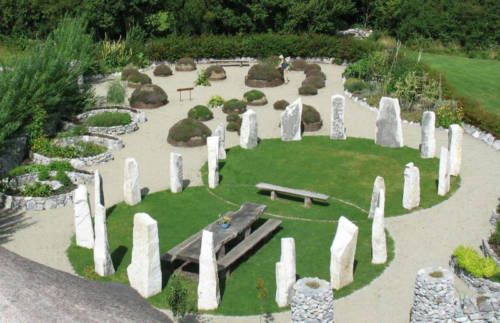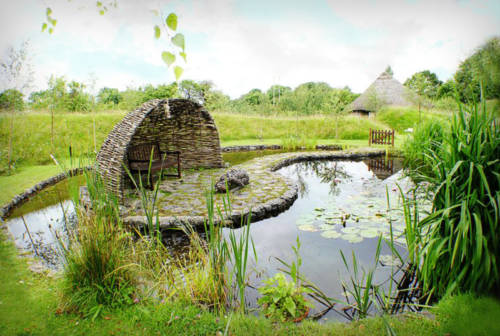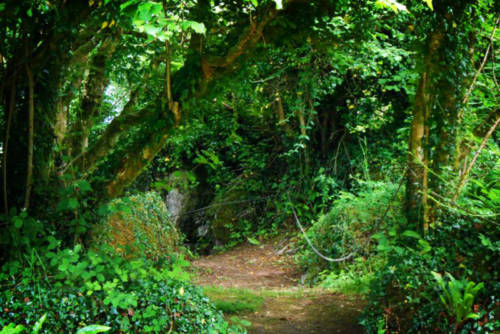Brigit’s Garden in Galway Brings Celtic Folklore to Life
In scenic west Ireland, Brigit’s Garden brings the magic and mythology of Ireland’s pagan past to modern life, in four gardens designed to match the ancient Celts’ four seasons. An enchanting place to stroll and find serenity, Brigit’s Garden is located on 11 acres of wildflower meadows and woodlands in County Galway. (The garden is just 12 miles from Galway City, in County Galway, which is on the Wild Atlantic Way, a 1,500-mile touring route on Ireland’s West Coast.) It’s also family-friendly, with events year-round, the likes of which include a Halloween bonfire, storytelling, a summer Sunrise Festival, and children’s play areas that include a tunnel of willow trees and nature trails.
The nonprofit garden took painstaking efforts to create. “We had to source 35 standing stones, create a 100-metre-long earth woman, turn copper hot-water tanks into artistic flames, build spiral-shaped stone walls, commission the art and craft works, build the Roundhouse, and much more,” said Jenny Beale, Director of Brigit’s Garden, who dreamed up the idea. Garden designer Mary Reynolds, winner of a Gold Medal at England’s Chelsea Flower Show in 2002, and who later designed gardens at the Royal Botanic Garden at Kew, implemented her ideas to form the garden that exists today. Jenny then oversaw local craftspeople, builders, volunteers and experts to put her ideas into practice before the garden opened in 2004.
Whimsy is alive and well in Brigit’s Garden, which has a Roundhouse, a charming thatch-roof conical stone structure (a dwelling common in Ireland and Britain during the Bronze Age and Iron Age), “wishing trees” (where wishes written on colorful paper hang from trees), and “fairy forts.” Thousands of these ring forts are left in Ireland, ancient circular settlements enclosed by earthen mounds, disturbing which many locals believe brings bad luck, since they’re “protected by spells”.
The most famous Celtic holiday, Samhain, marks the start of the Celts’ new year plus the start of winter. Later renamed Halloween after Ireland was Christianized (it was the “Hallowed Eve” before All Saints Day, November 1) Samhain was considered the time when the membrane between the world of the living and dead was thinnest, meaning the dead returned to walk among the living. Since the barren winter ground also held the hints of re-birth, the Samhain Garden fittingly has a bronze female sculpture reclining on a tiny island next to a lily pond, and a bank shaped like a woman. In summer, the woman-shaped bank is clad in wildflowers and grass, native Irish species like ox-eye daisy, wild marjoram, field scabious, and knapweed.
Who is Brigit?
The Celts’ spring festival, Imbolc, on February 1, when the first snowdrops appeared and lambs were born, was the time when the earth awoke from her slumber and life began again. In the Imbolc Garden, wildflower meadows feature spotted orchids and cowslips, and a path leads to a clearing with swings made of basketwork and a carved triple spiral that outlines the story of Brigit, whose feast day is February 1. Before she was a Christian saint (a contemporary of St. Patrick) and abbess who founded a monastery in Kildare in the 6th Century, Brigit was the Celtic goddess of the land. The St. Brigit’s Cross, a common symbol of Irish Christianity, was traditionally woven from rushes on her feast day and placed above the door of a home to bless all who entered and protect against fire and disease. Legend says Brigit wove one from rushes on the floor of a Celtic chieftain who lay dying, who converted on his death bed. Today, the rushes can be found in necklaces of silver or gold, or as a wall hanging.
The coming of summer on May 1 (May Day), which is called Bealtaine by the Celts, was celebrated with a fire festival. So in the Bealtaine Garden, copper flames are set in the ground between a path of standing stones, which lead to a throne of bog wood and a ceremonial fireplace. Summer also symbolized sexual awakening, so the Bealtaine garden has a grassy hollow surrounded by wildflowers, which symbolizes the bed of two star-crossed lovers in Irish legend.
“Summer also symbolized sexual awakening, so the Bealtaine garden has a grassy hollow surrounded by wildflowers, which symbolizes the bed of two star-crossed lovers in Irish legend.”
Legend says Grainne, the loveliest woman in lreland, was engaged to Finn MacCool, an aging chieftan and warrior. She fell in love with Diarmuid, a much younger man who was his friend, however, and the couple eloped. As they hid from the enraged MacCool in caves, trees, and crannies all over the country, a wild boar– the only animal capable of harming Diarmuid– gored him. Though Grainne begged the chieftain to save him with his magical powers, he hesitated, and her lover died.
The start of harvest time was marked in early August with an autumn festival by the Celts, called Lughnasa. So in the Lughnasa Garden, a herb garden is surrounded by spiral-shaped stones, earthen mounds symbolize harvest baskets and there’s space for feasting and dancing between two stone circles.
To learn more about Brigit’s Garden– including hours, transportation, and events– visit the garden’s website.





































